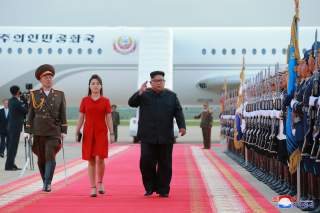Competing Economic Futures for the Korean Peninsula
Washington and Seoul cannot let Beijing unilaterally pursue its interests and influence without pushback.
As Seoul presses ahead with rapprochement with Pyongyang amidst the third summit between President Moon Jae-in and Chairman Kim Jong-un this week, it is becoming apparent that the stakes of diplomacy with North Korea far transcend the scope of nuclear disarmament. Beyond the formidable challenge of implementing a verifiable denuclearization protocol, the United States must navigate a delicate balance between supporting inter-Korean peace processes where appropriate, while ensuring that Beijing does not co-opt Pyongyang’s economic future.
Every regional stakeholder is currently pursuing its variant of triangular diplomacy, playing one major power off of the other to advance its interests. South Korea is no exception. Both Seoul and Beijing see tremendous opportunity in the economic transformation of North Korea, and the Moon administration’s bold economic initiatives have facilitated a rare alignment of strategic interests between South Korea and China.
Moon’s so-called New Economic Map Initiative offers but one obvious point of synchronicity with Beijing’s priorities. This week’s inter-Korean summit will feature a renewed focus on operationalizing Moon’s vision of building a continuous economic community on the Korean Peninsula, including his stated goal of establishing railway links with North Korea by the year’s end, as key South Korean business leaders join the delegation. Some estimates indicate that Moon’s plan to build out railway links between the two Koreas could add more than 1 percentage point to South Korea’s annual gross domestic product and could also generate seven hundred thousand jobs within the next five years. Meanwhile, linking the inter-Korean railway system to the Chinese mainland would not only offer Beijing an eastward extension of its overland infrastructure initiative but would also ensure that Chinese companies are well-positioned to dominate the North Korean market.
Physical infrastructure links with the North could also serve as the substructure for a more robust regional trading bloc, particularly as President Trump’s disruption of global markets has brought Beijing and Seoul together in unexpected ways. For instance, in subsequent negotiations for the Korea-China free trade agreement, which commenced earlier this year, the two countries’ trade and commerce ministers have—if only as a gesture of goodwill—pushed for further opening of the two countries’ service markets and stronger investor protection.
China is a pivotal player that quietly wields a large measure of influence over the success or failure of the United States’ diplomacy with North Korea. On the one hand, even as China and the United States are at loggerheads over trade, they still share the broadly common objective of ensuring that North Korea relinquishes its nuclear ambitions. Yet, China and America’s priorities diverge significantly when it comes to the economic transformation of North Korea and what a Northeast Asian economic community ought to look like. In particular, Beijing is angling to ensure that North Korea remains within its economic sphere of influence. As such, China has already steadily loosened restrictions on trade with North Korea, sometimes in contravention of United Nations Security Council Resolutions. From illegal coal shipments to a dramatic increase in Chinese tourism to North Korea, Beijing has reopened its doors to Pyongyang, casting the Kim regime a vital lifeline while implicitly weakening the United States’ diplomatic options.
As peace process between North and South Korea continues to make headway, including through the establishment of a joint liaison office in Kaesong last week, the risk of strain on the American-South Korean relationship and the convergence of interests between Seoul and Beijing will only grow. Irrespective of North Korea’s intentions for taking meaningful steps toward denuclearization within the next two and a half years, there is a growing appetite in both Seoul and Pyongyang for a formal peace accord. Beijing will capitalize on this momentum to the extent that it can to dictate the trajectory of North Korea’s economic development and thereby advance China’s own narrow national interests.
In the face of the profound challenges that Chinese illicit activity pose to sanctions discipline in the near-term future, and Beijing’s desire to shape the peninsula in the long term, the United States and South Korea need to step up coordination. In particular, the United States will need to make it crystal clear that Moon’s vision of building a single economic community on the Korean Peninsula is only possible under significant North Korean action toward denuclearization and requisite relief from existing American and United Nations sanctions.
More broadly, any American and allied strategy of deterrence and diplomacy with North Korea must be informed by the assumption that in the long term, the United States is in competition with China over the economic future of the Korean Peninsula. The manner in which the United States conducts this competition will impact the American-Chinese balance of power and the durability of the liberal, rules-based order in the region writ large.
Kristine Lee is a research associate with the Asia-Pacific Security Program at the Center for a New American Security (CNAS).
Image: North Korean leader Kim Jong Un is seen during his visit in Beijing, China, in this undated photo released June 20, 2018 by North Korea's Korean Central News Agency. KCNA via REUTERS

